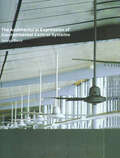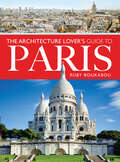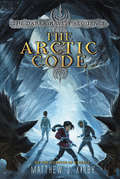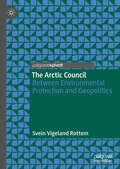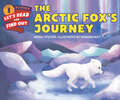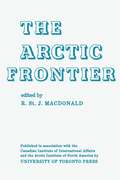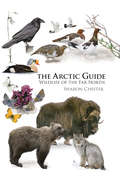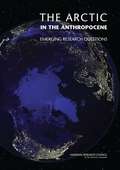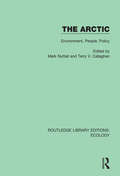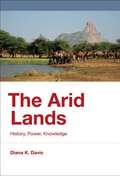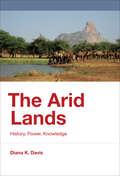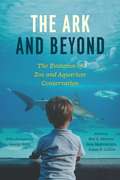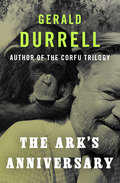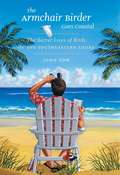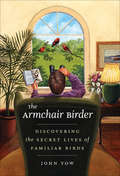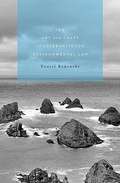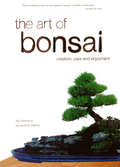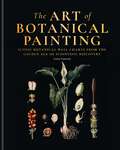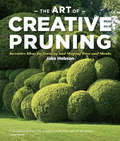- Table View
- List View
The Architectural Expression of Environmental Control Systems
by George BairdThe Architectural Expression of Environmental Control Systems examines the way project teams can approach the design and expression of both active and passive environmental control systems in a more creative way. Using seminal case studies from around the world and interviews with the architects and environmental engineers involved, the book illustrates innovative responses to client, site and user requirements, focusing upon elegant design solutions to a perennial problem. This book will inspire architects, building scientists and building services engineers to take a more creative approach to the design and expression of environmental control systems - whether active or passive, whether they influence overall building form or design detail.
The Architecture Lover's Guide to Paris (City Guides)
by Ruby BoukabouDiscover the architectural history behind Paris’s iconic building, famous landmarks, and charming neighborhoods with this handy visual guidebook.As you stroll the streets of Paris, this informative volume will help you unlock the secrets of the city’s beguiling beauty. Covering the major landmarks as well as dozens of lesser-known architectural gems, The Architecture Lover’s Guide to Paris puts essential history and fascinating details at your fingertips. Whether you are a Paris regular or visiting for the first time, this guide will help you understand how the city acquired its unique design palette. It also offers self-guided walking tours and suggestions of some of the best hotels, restaurants, cafés, churches, parks and more. You’ll discover ancient Roman baths, 17th century mansions, Art Deco theaters, and contemporary cultural complexes. You’ll also find out where to kick back, cocktail or mock-tail in hand, with a panoramic view over the capital. Written by Ruby Boukabou, author of The Art Lover’s Guide to Paris, this book is the perfect companion for anybody intrigued by the City of Light.
The Architecture of Green Economic Policies
by P. K. RaoThe role of environmental analysis in economic policy making has remained largely limited despite vast literature on environmental economics and governance. An effective integration of economic and environmental sciences with pragmatic design of institutions and policies is still urgently needed for practical use. This book offers a policy framework for economic policies that meaningfully integrate environmental and ecological resource factors. Based on analyses and new insights on sustainable development, this book provides pragmatic approaches for economic policy formulation and implementation, as well as for institutional reform. Thematic aspects include trade and environment, poverty and environment, recognition and accounting of factor limitations beyond traditional economic analyses, and an efficient choice of market and regulatory regimes for effective economic, environmental and social governance.
The Arctic Climate System
by Roger G. Barry Mark C. SerrezeThe Arctic can be viewed as an integrated system, characterised by intimate couplings between its atmosphere, ocean and land, linked in turn to the larger global system. This comprehensive, up-to-date assessment begins with an outline of early Arctic exploration and the growth of modern research. Using an integrated systems approach, subsequent chapters examine the atmospheric heat budget and circulation, the surface energy budget, the hydrologic cycle and interactions between the ocean, atmosphere and sea ice cover. Reviews of recent directions in numerical modelling and the characteristics of past Arctic climates set the stage for detailed discussion of recent climate variability and trends, and projected future states. Throughout, satellite remote sensing data and results from recent major field programs are used to illustrate key processes. The Arctic Climate System provides a comprehensive and accessible overview of the subject for researchers and advanced students in a wide range of disciplines.
The Arctic Code
by Matthew J. KirbyPerfect for fans of the Percy Jackson and Seven Wonders series, The Arctic Code is the first book in an epic, fast-paced middle grade adventure trilogy by acclaimed author Matthew J. Kirby.It is the near future, and the earth has entered a new ice age. Eleanor Perry lives in Tucson, one of the most popular destinations for refugees of the Freeze. She is the daughter of a climatologist who is trying to find new ways to preserve human life on the planet. Dr. Perry believes that a series of oil deposits she has found in the Arctic may hold the key to our survival. That's when she disappears--but not before sending Eleanor a series of cryptic messages that point to a significant and mysterious discovery. Now it's up to Eleanor to go find her.This search will launch Eleanor on a breathless race to unlock the mysteries of what has happened to our planet, solving the riddle of the cold that could be humanity's end--and uncovering a threat to the earth that may not be of this world.
The Arctic Council: Between Environmental Protection and Geopolitics
by Svein Vigeland RottemThis pivot introduces the Arctic Council and its role as a platform for dealing with local, national, regional and global challenges of relevance to the “new” Arctic. Against the backdrop of climate change and increasing commercial activity, it considers what a future Arctic should look like, from ideas of total protection to expansive oil and gas extraction. It examines the Arctic’s position on the political agenda, from Norway’s High North hype to a more peripheral place in the foreign policy of the US and explores the Council's role as an important international forum for dialogue and cooperation on Arctic challenges and opportunities, and a significant arena for developing knowledge and learning about a changing region.
The Arctic Fox's Journey (Let's-Read-and-Find-Out Science 1)
by Wendy PfefferRead and find out about the arctic fox’s quest for survival in this colorfully illustrated nonfiction picture book.During the winter, the arctic fox begins an incredible journey. She heads north through the tundra, toward the top of the world. No larger than a house cat, she faces treacherous obstacles, frightening predators, and bitter cold along the way. It seems impossible that she could persist against the elements on her almost 2,000-mile journey—but she does.This is a clear and appealing science book for early elementary age kids, both at home and in the classroom. The Arctic Fox’s Journey is filled with gorgeous, accurate art and includes tons of visual aids like charts, sidebars, an infographic, as well as a hands-on activity all about camouflage.This is a Level 1 Let's-Read-and-Find-Out, which means the book explores introductory concepts perfect for children in the primary grades. The 100+ titles in this leading nonfiction series are:hands-on and visualacclaimed and trustedgreat for classroomsTop 10 reasons to love LRFOs:Entertain and educate at the same timeHave appealing, child-centered topicsDevelopmentally appropriate for emerging readersFocused; answering questions instead of using survey approachEmploy engaging picture book quality illustrationsUse simple charts and graphics to improve visual literacy skillsFeature hands-on activities to engage young scientistsMeet national science education standardsWritten/illustrated by award-winning authors/illustrators & vetted by an expert in the fieldOver 130 titles in print, meeting a wide range of kids' scientific interestsBooks in this series support the Common Core Learning Standards, Next Generation Science Standards, and the Science, Technology, Engineering, and Math (STEM) standards. Let's-Read-and-Find-Out is the winner of the American Association for the Advancement of Science/Subaru Science Books & Films Prize for Outstanding Science Series.
The Arctic Frontier (The Royal Society of Canada Special Publications)
by Ronald MacDonaldThe idea of the Arctic Ocean as a mediterranean sea is a shock to those of us—and that includes most of us—who cannot shake ourselves free of the Mercatorean vision. Yet this theme is repeated by many of the eminent ocntributors to this volume: as Michael Marsden states, "IT is difficult to impress upon the public and industry at large that the most essential quality of the Arctic is not cold, or gold, or polar bears, but a central position in the world community." This book, then, is about the North as a frontier, and about Canada's relations with the world beyond that frontier. It is about the Arctic community of which Canada is one of the major members, along with the Soviet Union, the United States, Denmark, Iceland, and Norway. It is also an exercise in perspective. Canadians have long been aware of the significance of their Atlantic and Pacific frontiers and of the implications of their Southern frontier. This volume points out that Canada is not a three-sided country. While it does not neglect the military importance of the Arctic, it endeavours to widen the scope of interest. But it does not present the familiar arguments about the surpassing importance of the Arctic. It deflates as well as inflates. Its purpose is to assess as precisely as possible the implications of the Arctic frontier, not to induce either visions or nightmares. It is intended not only for Canadians but for all those who are interested in the polar regions or in the shape of the world at large. The papers in this volume were assembled in collaboration by the Canadian Institute of International Affairs and the Arctic Institute of North America.
The Arctic Guide: Wildlife of the Far North
by Sharon ChesterThe Arctic Guide presents the traveler and naturalist with a portable, authoritative guide to the flora and fauna of earth's northernmost region. Featuring superb color illustrations, this one-of-a-kind book covers the complete spectrum of wildlife--more than 800 species of plants, fishes, butterflies, birds, and mammals--that inhabit the Arctic's polar deserts, tundra, taiga, sea ice, and oceans. It can be used anywhere in the entire Holarctic region, including Norway's Svalbard archipelago, Siberia, the Russian Far East, islands of the Bering Sea, Alaska, the Canadian Arctic, and Greenland. Detailed species accounts describe key identification features, size, habitat, range, scientific name, and the unique characteristics that enable these organisms to survive in the extreme conditions of the Far North. A color distribution map accompanies each species account, and alternative names in German, French, Norwegian, Russian, Inuit, and Inupiaq are also provided. Features superb color plates that allow for quick identification of more than 800 species of plants, fishes, butterflies, birds, and mammals Includes detailed species accounts and color distribution maps Covers the flora and fauna of the entire Arctic region
The Arctic in the Anthropocene: Emerging Research Questions
by Committee on Emerging Research Questions in the ArcticOnce ice-bound, difficult to access, and largely ignored by the rest of the world, the Arctic is now front and center in the midst of many important questions facing the world today. Our daily weather, what we eat, and coastal flooding are all interconnected with the future of the Arctic. The year 2012 was an astounding year for Arctic change. The summer sea ice volume smashed previous records, losing approximately 75 percent of its value since 1980 and half of its areal coverage. Multiple records were also broken when 97 percent of Greenland's surface experienced melt conditions in 2012, the largest melt extent in the satellite era. Receding ice caps in Arctic Canada are now exposing land surfaces that have been continuously ice covered for more than 40,000 years. What happens in the Arctic has far-reaching implications around the world. Loss of snow and ice exacerbates climate change and is the largest contributor to expected global sea level rise during the next century. Ten percent of the world's fish catches comes from Arctic and sub-Arctic waters. The U. S. Geological Survey estimated that up to 13 percent of the world's remaining oil reserves are in the Arctic. The geologic history of the Arctic may hold vital clues about massive volcanic eruptions and the consequent release of massive amount of coal fly ash that is thought to have caused mass extinctions in the distant past. How will these changes affect the rest of Earth? What research should we invest in to best understand this previously hidden land, manage impacts of change on Arctic communities, and cooperate with researchers from other nations? "The Arctic in the Anthropocene" reviews research questions previously identified by Arctic researchers, and then highlights the new questions that have emerged in the wake of and expectation of further rapid Arctic change, as well as new capabilities to address them. This report is meant to guide future directions in U. S. Arctic research so that research is targeted on critical scientific and societal questions and conducted as effectively as possible. "The Arctic in the Anthropocene" identifies both a disciplinary and a cross-cutting research strategy for the next 10 to 20 years, and evaluates infrastructure needs and collaboration opportunities. The climate, biology, and society in the Arctic are changing in rapid, complex, and interactive ways. Understanding the Arctic system has never been more critical; thus, Arctic research has never been more important. This report will be a resource for institutions, funders, policy makers, and students. Written in an engaging style, "The Arctic in the Anthropocene" paints a picture of one of the last unknown places on this planet, and communicates the excitement and importance of the discoveries and challenges that lie ahead.
The Arctic: Environment, People, Policy (Routledge Library Editions: Ecology #10)
by Mark Nuttall Terry V. CallaghanOriginally published in 2000, The Arctic provides a comprehensive overview of the region's rapidly changing physical and human dimensions, and demonstrates the importance of communication between natural scientists, social scientists, and local stakeholders in response to the tremendous challenges and opportunities facing the Arctic. It is an essential resource for all Arctic researchers, particularly those developing multidisciplinary projects. It provides an overview of key areas of Arctic research by renowned specialists in the field, and each chapter forms a detailed, varied and accessible account of current knowledge. Each author introduces the subject to a specialist readership, while retaining intellectual integrity and relevance for specialists. Overall, the richness of the material presented in this volume reflects the ecological and cultural diversity of this vast and environmentally critical part of the globe.
The Arid Lands: History, Power, Knowledge
by Diana K. DavisDeserts are commonly imagined as barren, defiled, worthless places, wastelands in need of development. This understanding has fueled extensive anti-desertification efforts -- a multimillion-dollar global campaign driven by perceptions of a looming crisis. In this book, Diana Davis argues that estimates of desertification have been significantly exaggerated and that deserts and drylands -- which constitute about 41% of the earth's landmass -- are actually resilient and biodiverse environments in which a great many indigenous people have long lived sustainably. Meanwhile, contemporary arid lands development programs and anti-desertification efforts have met with little success. As Davis explains, these environments are not governed by the equilibrium ecological dynamics that apply in most other regions. Davis shows that our notion of the arid lands as wastelands derives largely from politically motivated Anglo-European colonial assumptions that these regions had been laid waste by "traditional" uses of the land. Unfortunately, such assumptions still frequently inform policy. Drawing on political ecology and environmental history, Davis traces changes in our understanding of deserts, from the benign views of the classical era to Christian associations of the desert with sinful activities to later (neo)colonial assumptions of destruction. She further explains how our thinking about deserts is problematically related to our conceptions of forests and desiccation. Davis concludes that a new understanding of the arid lands as healthy, natural, but variable ecosystems that do not necessarily need improvement or development will facilitate a more sustainable future for the world's magnificent drylands.
The Arid Lands: History, Power, Knowledge (History for a Sustainable Future)
by Diana K. DavisAn argument that the perception of arid lands as wastelands is politically motivated and that these landscapes are variable, biodiverse ecosystems, whose inhabitants must be empowered. Deserts are commonly imagined as barren, defiled, worthless places, wastelands in need of development. This understanding has fueled extensive anti-desertification efforts—a multimillion-dollar global campaign driven by perceptions of a looming crisis. In this book, Diana Davis argues that estimates of desertification have been significantly exaggerated and that deserts and drylands—which constitute about 41% of the earth's landmass—are actually resilient and biodiverse environments in which a great many indigenous people have long lived sustainably. Meanwhile, contemporary arid lands development programs and anti-desertification efforts have met with little success. As Davis explains, these environments are not governed by the equilibrium ecological dynamics that apply in most other regions. Davis shows that our notion of the arid lands as wastelands derives largely from politically motivated Anglo-European colonial assumptions that these regions had been laid waste by “traditional” uses of the land. Unfortunately, such assumptions still frequently inform policy. Drawing on political ecology and environmental history, Davis traces changes in our understanding of deserts, from the benign views of the classical era to Christian associations of the desert with sinful activities to later (neo)colonial assumptions of destruction. She further explains how our thinking about deserts is problematically related to our conceptions of forests and desiccation. Davis concludes that a new understanding of the arid lands as healthy, natural, but variable ecosystems that do not necessarily need improvement or development will facilitate a more sustainable future for the world's magnificent drylands.
The Ark and Beyond: The Evolution of Zoo and Aquarium Conservation (Convening Science: Discovery At The Marine Biological Laboratory Ser.)
by Ben A. Minteer Jane Maienschein James P. CollinsScores of wild species and ecosystems around the world face a variety of human-caused threats, from habitat destruction and fragmentation to rapid climate change. But there is hope, and it, too, comes in a most human form: zoos and aquariums. Gathering a diverse, multi-institutional collection of leading zoo and aquarium scientists as well as historians, philosophers, biologists, and social scientists, The Ark and Beyond traces the history and underscores the present role of these organizations as essential conservation actors. It also offers a framework for their future course, reaffirming that if zoos and aquariums make biodiversity conservation a top priority, these institutions can play a vital role in tackling conservation challenges of global magnitude. While early menageries were anything but the centers of conservation that many zoos are today, a concern with wildlife preservation has been an integral component of the modern, professionally run zoo since the nineteenth century. From captive breeding initiatives to rewilding programs, zoos and aquariums have long been at the cutting edge of research and conservation science, sites of impressive new genetic and reproductive techniques. Today, their efforts reach even further beyond recreation, with educational programs, community-based conservation initiatives, and international, collaborative programs designed to combat species extinction and protect habitats at a range of scales. Addressing related topics as diverse as zoo animal welfare, species reintroductions, amphibian extinctions, and whether zoos can truly be “wild,” this book explores the whole range of research and conservation practices that spring from zoos and aquariums while emphasizing the historical, scientific, and ethical traditions that shape these efforts. Also featuring an inspiring foreword by the late George Rabb, president emeritus of the Chicago Zoological Society / Brookfield Zoo, The Ark and Beyond illuminates these institutions’ growing significance to the preservation of global biodiversity in this century.
The Ark's Anniversary (Windsor Ser.)
by Gerald DurrellThe conservationist whose work inspired Masterpiece production The Durrells in Corfu recounts the early years of the Durrell Wildlife Park. At the age of six, Gerald Durrell confidently told his mother he would one day have his own zoo. She told him it was a lovely idea and promptly forgot all about it. But the young naturalist&’s passion wasn&’t about to fade away any time soon. Written for the Durrell Wildlife Park&’s twenty-fifth anniversary, The Ark&’s Anniversary is the unconventional story of how one man&’s dream was transformed into the esteemed organization known today as the Durrell Wildlife Conservation Trust, dedicated to saving endangered species from extinction. In the beginning, everyone thought Durrell was crazy to place a zoo on the island of Jersey in the English Channel. But that didn&’t stop people from coming to see him and his menagerie of rare and exotic animals, including celebrities like Richard Adams, Princess Grace, David Niven (who presided over the wedding of two apes), and Princess Anne (who wrote the foreword to this book). The Ark&’s Anniversary is a delightful journey and a celebration of success for anyone who loves the natural world. This ebook features an illustrated biography of Gerald Durrell including rare photos from the author&’s estate.
The Armchair Birder Goes Coastal
by John YowWith his distinctively witty, anecdotal, and disarming voice, John Yow now journeys to the shore and shares his encounters with some of the most familiar and beloved coastal birds. Out of his travels--from North Carolina's Outer Banks, down the Atlantic coast, and westward along the Gulf of Mexico--come colorful accounts of twenty-eight species, from ubiquitous beach birds like sanderlings and laughing gulls to wonders of nature like roseate spoonbills and the American avocets. Along the way, Yow delves deeply into the birds' habits and behaviors, experiencing and relating the fascination that leads many an amateur naturalist to become the most unusual of species--a birder.Seasonally organized chapters explore the improbable, the wonderful, and the amusing aspects of these birds' lives. Yow embellishes his observations with field notes, anecdotes, and stories from some of America's finest naturalists--including John James Audubon, Arthur Cleveland Bent, Rachel Carson, and Peter Matthiessen. Combining the endless fascination of bird life with the pleasure of good reading, The Armchair Birder Goes Coastal is the perfect companion for any nature lover's next trip to the beach.
The Armchair Birder's Omnibus Ebook
by John YowAvailable for the first time together in this Omnibus E-Book, The Armchair Birder's Omnibus brings together both of John Yow's delightful books into one convenient e-book.While birding literature is filled with tales of expert observers spotting rare species in exotic locales, John Yow reminds us in The Armchair Birder, that the most fascinating birds can be the ones perched right outside our windows. In thirty-five engaging and sometimes irreverent vignettes, Yow reveals the fascinating lives of the birds we see nearly every day. Following the seasons, he covers forty-two species, discussing the improbable, unusual, and comical aspects of his subjects' lives. Yow offers his own observations, anecdotes, and stories as well as those of America's classic bird writers, such as John James Audubon, Arthur Bent, and Edward Forbush. This unique addition to bird literature combines the fascination of bird life with the pleasure of good reading.In his follow-up volume The Armchair Birder Goes Coastal, Yow now journeys to the shore and shares his encounters with some of the most familiar and beloved coastal birds. Out of his travels--from North Carolina's Outer Banks, down the Atlantic coast, and westward along the Gulf of Mexico--come colorful accounts of twenty-eight species, from ubiquitous beach birds like sanderlings and laughing gulls to wonders of nature like roseate spoonbills and the American avocets. Along the way, Yow delves deeply into the birds' habits and behaviors, experiencing and relating the fascination that leads many an amateur naturalist to become the most unusual of species--a birder.
The Armchair Birder: Discovering the Secret Lives of Familiar Birds
by John YowBird lovers, take heart! While the birding literature is filled with tales of expert observers spotting rare species in exotic locales, John Yow's The Armchair Birder reminds us that the most fascinating birds can be the ones perched right outside our windows. In thirty-five engaging, humorous, and even irreverent essays, Yow reveals the fascinating lives of birds you probably already recognize and naturally want to know more about--because they're the ones you see nearly every day. Following the seasons of the year, Yow covers forty-two species, from the Carolina wren that rings in the springtime to the sandhill crane croaking high overhead at the end of winter. Leisurely and entertaining, the essays explore the improbable, unusual, and comical aspects of their subjects' lives--from the philandering of the ruby-throated hummingbird to the occasional dipsomania of the cedar waxwing. Rather than bare facts and field marks, The Armchair Birder offers observations, anecdotes, and stories--not only Yow's own, but also those of America's classic bird writers, such as John James Audubon, Arthur Bent, and Edward Forbush, experts who saw it all and wrote with wit and passion. With The Armchair Birder, backyard birders will take new delight in the birds at their feeders, while veteran check-listers will enjoy putting their feet up. All will applaud this unique addition to bird literature, one that combines the fascination of bird life with the pleasure of good reading.
The Art Of Keeping Snakes
by Philippe De VosjoliFor author Philippe de Vosjoli, "art is the actualization of a personal vision or message," and de Vosjoli's passion is snakes, which he believes are among the most beautiful animals on earth. Incorporating snakes into a naturalistic vivarium, the way lizards and amphibians usually are, adds a new element to snake keeping, elevating the hobby to a true art form. In The Art of Keeping Snakes, de Vosjoli pursues this concept and provides advice for snake keepers who wish to create beautiful displays for their snakes, putting the animals' welfare and quality of life above all else and simultaneously enhancing their own enjoyment in observing their beautiful snakes in naturalistic environments. Beautifully photographed, inspiring, and informative, The Art of Keeping Snakes is divided into two parts, the first "A New Way to Keep Snakes," discusses design planning, enclosures and background possibilities, substrates, landscaping, plants, heating/lighting, quarantine and introducing the snakes to the vivarium. This part also includes chapters on feeding, handling, health care, and general maintenance and husbandry. The second part, "Best Display Snakes," presents over thirty different snakes, including photographs, physical descriptions, and tips for selection, handling, vivarium design tips, feeding, and breeding. The snakes in this part are divided into chapters, categorized by pythons, boas, water and garter snakes, hognose snakes, rat snakes, kingsnakes and milksnakes, and others. Resources and index included.
The Art and Craft of International Environmental Law
by Daniel BodanskyThe book focuses on the processes by which international environmental law is developed, implemented and enforced rather than on the substance of international environmental law itself-- already the subject of several excellent treatises. Process issues have received increased attention in recent years but have not yet received a book-length treatment. This work aims to fill that gap. Rather than focus on one or two aspects of the international environmental process, it examines the process as a whole, from beginning to end, synthesizing recent research on international environmental negotiations, treaty design, social norms, policy implementation and effectiveness. Understanding the international environmental process involves many disciplines--not only law, but also political science, economics, and, to a more limited degree, philosophy, sociology and anthropology. So this book is multidisciplinary. The aim is to provide the reader with the analytical tools necessary to understand what international environmental law is, how it operates, and what role it can play in addressing environmental problems.
The Art of Bonsai
by Giovanna M. Halford Yuji YoshimuraLearn the ins and outs of proper bonsai design and care with this comprehensive Japanese gardening book.Japanese bonsai have long been admired throughout the world while their care and preservation have seemed shrouded in mystery. The Art of Bonsai is, however, a comparatively simple art to learn. Anyone with a love a plants, a little patience and this eminently practical book can create bonsai and keep a finished plant healthy and vigorous for generations.Included in this definitive volume are:Detailed, illustrated instructions on propagation and trainingHints for those growing bonsai in a hurry and apartment dwellersDaily and seasonal bonsai care practicesDealing with pests and bonsai troubleshootingHow to judge, select and exhibit bonsaiDetailed appendices on tools, equipment, soil analysesData on more than 300 species of plants used in making bonsaiThis classic work remains an eminently practical book and is the classic guide to bonsai care. It contains the essentials of an art that is one of Japan's most treasured traditions--sculpting beauty in living wood.
The Art of Botanical Painting: Art from the golden age of scientific discovery
by Anna LaurentDiscover the wonders of the natural world with this beautiful collection of botanical paintings from around the globe.The opening of the 19th century ushered in an age of unprecedented scientific discovery and artistry. As the development of the microscope allowed scientists access to a previously unimaginable world in miniature, and naturalists travelling the globe sent home reports of weird and wonderful species, there was a growing desire for knowledge of the natural world.Through the medium of popular botanical wall charts, botanical drawing and painting was able to bring this new area of exploration out of the elite salons and universities and into classrooms and homes.This book is a celebration of these botanical wall charts, and the fantastic convergence of art and science they represent. With the artworks taking centre stage, accompanied by text that gives insight into the historical, botanical and artistic context, this unique collection will delight and fascinate botanists, devotees of beautiful vintage illustration, and all with an interest in the natural world.
The Art of Botanical Painting: Art from the golden age of scientific discovery
by Anna LaurentDiscover the wonders of the natural world with this beautiful collection of botanical paintings from around the globe.The opening of the 19th century ushered in an age of unprecedented scientific discovery and artistry. As the development of the microscope allowed scientists access to a previously unimaginable world in miniature, and naturalists travelling the globe sent home reports of weird and wonderful species, there was a growing desire for knowledge of the natural world.Through the medium of popular botanical wall charts, botanical drawing and painting was able to bring this new area of exploration out of the elite salons and universities and into classrooms and homes.This book is a celebration of these botanical wall charts, and the fantastic convergence of art and science they represent. With the artworks taking centre stage, accompanied by text that gives insight into the historical, botanical and artistic context, this unique collection will delight and fascinate botanists, devotees of beautiful vintage illustration, and all with an interest in the natural world.
The Art of Camping: The History and Practice of Sleeping Under the Stars
by Matthew De AbaituaCould there be another way of life? Can I survive with less stuff? Should I run for the hills?These are all good questions that people have asked before, throughout history, and which have inspired people to set up camp. But now camping is part of the drive for self-sufficiency, a reaction against mass tourism, a chance to connect with the land, to experience a community, to leave no trace . . . From packing to pitching, with hikes into the deep history of the subject and encounters with the great campers and camping movements of the past, this is the only book you'll need to pack when you next head off to sleep under the stars.IF THERE IS ONE THING THAT CAMPERS LIKE MORE THAN CAMPING, IT'S DREAMING ABOUT THEIR NEXT TRIP
The Art of Creative Pruning: Inventive Ideas for Training and Shaping Trees and Shrubs
by Jake HobsonNothing brings a touch of artistry to the garden like ornamental pruning, and a series of deliberate cuts can create landscapes and evoke faraway places. All that's needed to recreate the effect in the garden are a sharp pair of pruners, some imagination, and the instruction found in The Art of Creative Pruning. Drawing on both eastern and western styles, author Jake Hobson moves beyond the traditional lollipops and animals and teaches a wholly new approach to ornamental pruning that appeals to modern sensibilities. Picture boxwoods trimmed into whimsical Russian nesting dolls, hedges inscribed with words, and a tree snipped to resemble the toppling tiers of a wedding cake. These are just a few of the unusual ideas featured in the beautifully photographed pages. All the practical considerations are here as well, including pruning to improve a view, remedial pruning to fix problems, and pruning fruit trees to increase yield.
